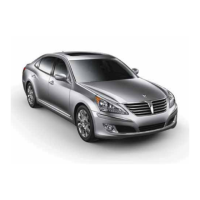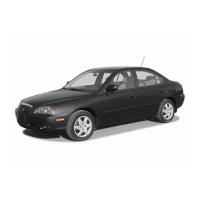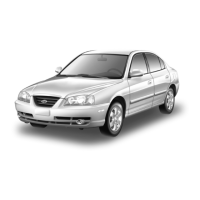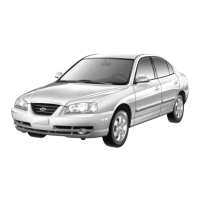Do you have a question about the Hyundai EON and is the answer not in the manual?
Defines a situation indicating potential harm, serious injury, or death if the warning is ignored.
Defines a situation indicating potential damage to the vehicle or its equipment if the caution is ignored.
Indicates interesting or helpful information is being provided.
Details the warranty coverage, period, and conditions for new Hyundai vehicles.
Outlines the warranty terms for genuine Hyundai replacement parts installed by an authorized dealer.
Covers components liable to affect vehicle emissions, ensuring compliance with standards.
Outlines the owner's duties for maintaining the vehicle and adhering to warranty terms.
Provides guidance on navigating the manual, understanding its layout, and utilizing its features for optimal vehicle operation.
Specifies the type of fuel and octane rating required for the vehicle's gasoline engine to ensure performance and minimize emissions.
Offers simple precautions for the first 1,000 km to enhance vehicle performance, economy, and lifespan.
Identifies and describes key interior components and their locations within the vehicle cabin.
Details the various controls and indicators found on the vehicle's instrument panel for driver information.
Illustrates and labels the main components located within the vehicle's engine compartment for identification.
Explains the adjustment and features of front and rear seats, including headrests and folding mechanisms.
Details the proper use, restraint system, and care of seat belts for maximum safety protection.
Provides essential information and warnings regarding the correct installation and use of child restraint systems.
Explains the operation, components, and precautions associated with the vehicle's air bag system.
Describes the functions of the ignition key and highlights safety warnings related to its use, especially with children.
Explains the operation of the remote keyless entry system, including lock, unlock functions, and transmitter precautions.
Details the operation of interior and exterior door locks, including central locking and child-protector features.
Covers the operation of power and manual windows, along with important safety warnings and precautions.
Explains the electronic power steering system, tilt steering adjustment, and horn operation for driver comfort and control.
Identifies and describes the various gauges, indicators, and warning lights on the instrument cluster.
Lists essential pre-drive checks, necessary inspections, and starting procedures for safe vehicle operation.
Provides step-by-step instructions for starting the engine, emphasizing safety precautions and proper pedal usage.
Explains the operation of power brakes, parking brake, and critical actions in case of brake failure or wet conditions.
Offers driving suggestions and vehicle maintenance tips to improve fuel economy and reduce operating costs.
Provides guidance on driving in snowy or icy conditions, including the use of snow tires and tire chains.
Details the procedure for changing a flat tyre, including jack usage, tyre removal, and installation safety.
Addresses common reasons for an engine not starting and provides troubleshooting steps for over-cranking or no-start conditions.
Outlines immediate actions to take if the engine overheats, including checking coolant and drive belts.
Explains recommended towing procedures, including the use of dollies or flatbeds and precautions to prevent vehicle damage.
Presents normal and severe usage maintenance schedules for various vehicle components and systems.
Guides on how to check and change engine oil and filter, including important warnings and recommended specifications.
Details how to check and maintain the engine coolant level, including safety warnings for hot engines and recommended coolant mixtures.
Covers tyre care, inflation pressure, rotation, replacement, and wheel alignment for optimal safety and performance.
Explains the location and function of fuse panels, how to replace fuses, and identifies common fuse ratings and protected components.
Provides instructions for battery service, recharging, and safety warnings related to handling batteries and electrical systems.
Lists key physical dimensions of the vehicle, including length, width, height, and wheelbase.
Specifies the recommended types and quantities of lubricants and fluids for various vehicle systems.
Guides on understanding tyre size designations, tread wear, traction, temperature grades, and inflation pressures.
Defines a situation indicating potential harm, serious injury, or death if the warning is ignored.
Defines a situation indicating potential damage to the vehicle or its equipment if the caution is ignored.
Indicates interesting or helpful information is being provided.
Details the warranty coverage, period, and conditions for new Hyundai vehicles.
Outlines the warranty terms for genuine Hyundai replacement parts installed by an authorized dealer.
Covers components liable to affect vehicle emissions, ensuring compliance with standards.
Outlines the owner's duties for maintaining the vehicle and adhering to warranty terms.
Provides guidance on navigating the manual, understanding its layout, and utilizing its features for optimal vehicle operation.
Specifies the type of fuel and octane rating required for the vehicle's gasoline engine to ensure performance and minimize emissions.
Offers simple precautions for the first 1,000 km to enhance vehicle performance, economy, and lifespan.
Identifies and describes key interior components and their locations within the vehicle cabin.
Details the various controls and indicators found on the vehicle's instrument panel for driver information.
Illustrates and labels the main components located within the vehicle's engine compartment for identification.
Explains the adjustment and features of front and rear seats, including headrests and folding mechanisms.
Details the proper use, restraint system, and care of seat belts for maximum safety protection.
Provides essential information and warnings regarding the correct installation and use of child restraint systems.
Explains the operation, components, and precautions associated with the vehicle's air bag system.
Describes the functions of the ignition key and highlights safety warnings related to its use, especially with children.
Explains the operation of the remote keyless entry system, including lock, unlock functions, and transmitter precautions.
Details the operation of interior and exterior door locks, including central locking and child-protector features.
Covers the operation of power and manual windows, along with important safety warnings and precautions.
Explains the electronic power steering system, tilt steering adjustment, and horn operation for driver comfort and control.
Identifies and describes the various gauges, indicators, and warning lights on the instrument cluster.
Lists essential pre-drive checks, necessary inspections, and starting procedures for safe vehicle operation.
Provides step-by-step instructions for starting the engine, emphasizing safety precautions and proper pedal usage.
Explains the operation of power brakes, parking brake, and critical actions in case of brake failure or wet conditions.
Offers driving suggestions and vehicle maintenance tips to improve fuel economy and reduce operating costs.
Provides guidance on driving in snowy or icy conditions, including the use of snow tires and tire chains.
Details the procedure for changing a flat tyre, including jack usage, tyre removal, and installation safety.
Addresses common reasons for an engine not starting and provides troubleshooting steps for over-cranking or no-start conditions.
Outlines immediate actions to take if the engine overheats, including checking coolant and drive belts.
Explains recommended towing procedures, including the use of dollies or flatbeds and precautions to prevent vehicle damage.
Presents normal and severe usage maintenance schedules for various vehicle components and systems.
Guides on how to check and change engine oil and filter, including important warnings and recommended specifications.
Details how to check and maintain the engine coolant level, including safety warnings for hot engines and recommended coolant mixtures.
Covers tyre care, inflation pressure, rotation, replacement, and wheel alignment for optimal safety and performance.
Explains the location and function of fuse panels, how to replace fuses, and identifies common fuse ratings and protected components.
Provides instructions for battery service, recharging, and safety warnings related to handling batteries and electrical systems.
Lists key physical dimensions of the vehicle, including length, width, height, and wheelbase.
Specifies the recommended types and quantities of lubricants and fluids for various vehicle systems.
Guides on understanding tyre size designations, tread wear, traction, temperature grades, and inflation pressures.
| Brand | Hyundai |
|---|---|
| Model | EON |
| Category | Automobile |
| Language | English |












